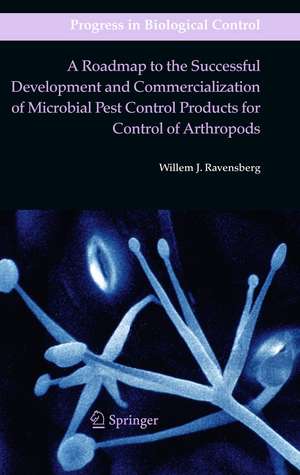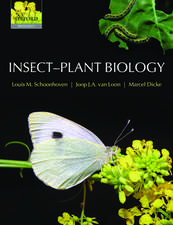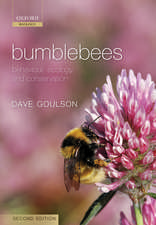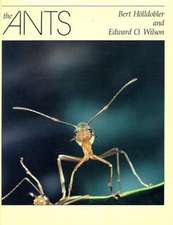A Roadmap to the Successful Development and Commercialization of Microbial Pest Control Products for Control of Arthropods: Progress in Biological Control, cartea 10
Autor Willem J. Ravensbergen Limba Engleză Paperback – 21 apr 2013
| Toate formatele și edițiile | Preț | Express |
|---|---|---|
| Paperback (1) | 1222.01 lei 6-8 săpt. | |
| SPRINGER NETHERLANDS – 21 apr 2013 | 1222.01 lei 6-8 săpt. | |
| Hardback (1) | 1226.73 lei 6-8 săpt. | |
| SPRINGER NETHERLANDS – 3 feb 2011 | 1226.73 lei 6-8 săpt. |
Din seria Progress in Biological Control
- 18%
 Preț: 952.57 lei
Preț: 952.57 lei - 18%
 Preț: 1381.58 lei
Preț: 1381.58 lei - 18%
 Preț: 955.25 lei
Preț: 955.25 lei - 18%
 Preț: 956.33 lei
Preț: 956.33 lei - 15%
 Preț: 632.19 lei
Preț: 632.19 lei - 24%
 Preț: 1054.23 lei
Preț: 1054.23 lei - 15%
 Preț: 657.25 lei
Preț: 657.25 lei - 15%
 Preț: 649.06 lei
Preț: 649.06 lei - 18%
 Preț: 1412.20 lei
Preț: 1412.20 lei - 18%
 Preț: 942.76 lei
Preț: 942.76 lei - 24%
 Preț: 797.39 lei
Preț: 797.39 lei - 18%
 Preț: 1117.03 lei
Preț: 1117.03 lei - 18%
 Preț: 948.16 lei
Preț: 948.16 lei - 15%
 Preț: 652.17 lei
Preț: 652.17 lei - 15%
 Preț: 653.14 lei
Preț: 653.14 lei - 18%
 Preț: 956.81 lei
Preț: 956.81 lei - 18%
 Preț: 1234.77 lei
Preț: 1234.77 lei - 18%
 Preț: 936.29 lei
Preț: 936.29 lei - 18%
 Preț: 1225.94 lei
Preț: 1225.94 lei
Preț: 1222.01 lei
Preț vechi: 1490.25 lei
-18% Nou
Puncte Express: 1833
Preț estimativ în valută:
233.86€ • 253.94$ • 196.44£
233.86€ • 253.94$ • 196.44£
Carte tipărită la comandă
Livrare economică 22 aprilie-06 mai
Preluare comenzi: 021 569.72.76
Specificații
ISBN-13: 9789400735156
ISBN-10: 9400735154
Pagini: 412
Ilustrații: XXVI, 386 p.
Dimensiuni: 155 x 235 x 22 mm
Greutate: 0.57 kg
Ediția:2011
Editura: SPRINGER NETHERLANDS
Colecția Springer
Seria Progress in Biological Control
Locul publicării:Dordrecht, Netherlands
ISBN-10: 9400735154
Pagini: 412
Ilustrații: XXVI, 386 p.
Dimensiuni: 155 x 235 x 22 mm
Greutate: 0.57 kg
Ediția:2011
Editura: SPRINGER NETHERLANDS
Colecția Springer
Seria Progress in Biological Control
Locul publicării:Dordrecht, Netherlands
Public țintă
ResearchCuprins
List of Acronyms and Abbreviations.- Chapter 1. General introduction and outline.- Chapter 2. Selection of a new microbial pest control agent.- Chapter 3. Mass production and product development of a microbial pest control agent.- Chapter 4. Quality control.- Chapter 5. Registration of microbial pest control agents and products and other related regulations. Chapter 6. Implementation of a microbial pest control product in an integrated pest management programme.- Chapter 7. Critical factors in the successful commercialization of microbial pest control products.- Chapter 8. Roadmap to success and future perspective.
Recenzii
From the reviews:
“As far as I know, no one has attempted this task in book form, and certainly not in such detail, and with so many real-life examples provided to document the conclusions. … a valuable addition to the libraries of university, industrial and government researchers, as well as business persons, policy makers and regulators. … Ravensberg analyzes both successful and failed products, identifying the factors shared by each. These analyses are instructive for researchers and companies who are embarking on new projects … .” (Wendy Gelernter, Society for Invertebrate Pathology Newsletter, Vol. 44 (3), November, 2011)
“As far as I know, no one has attempted this task in book form, and certainly not in such detail, and with so many real-life examples provided to document the conclusions. … a valuable addition to the libraries of university, industrial and government researchers, as well as business persons, policy makers and regulators. … Ravensberg analyzes both successful and failed products, identifying the factors shared by each. These analyses are instructive for researchers and companies who are embarking on new projects … .” (Wendy Gelernter, Society for Invertebrate Pathology Newsletter, Vol. 44 (3), November, 2011)
Textul de pe ultima copertă
Biocontrol is among the most promising methods for a safe, environmentally benign and sustainable crop protection. Microbial pesticides offer a great potential, and it is anticipated that they will become a substantial part of the use of all crop protection products. Their development and commercialization, however, has been difficult and with many failures.
For the first time, a rational and structured roadmap has been designed for the development and commercialization of microbial pest control products, based on entomopathogenic bacteria, fungi, viruses and nematodes, for the control of arthropod pests. The emphasis lies on strain screening, product development, up to successful commercialization, from a bio-industry’s viewpoint.
The building blocks of the entire process are identified. The selection criteria for a microbial pest control agent are defined as well as critical parameters for the development of the product. Implementation of the product into an integrated pest management programme is pivotal for a substantial market uptake. Three phases are distinguished for successful adoption in the market: an appropriate application strategy, an optimal implementation strategy, and an effective adoption strategy. Key success and failure factors are identified. Registration is a major hurdle for biopesticides. Salient registration issues are treated and useful information presented.
The road to a successful microbial pest control product is designed. Diagrams illustrate the stepwise approach of the entire process. A future perspective on the biopesticide market is presented with limiting and promotional factors and trends. The significant drivers for success are food safety concern, new research and technology, changes in the regulatory climate, and the occurrence of new invasive pests.
This systematic roadmap with a strongfocus on economics and market introduction will assist academic researchers and industrial developers of biopesticides in accomplishing their goal: the development of successful cost-effective microbial pesticides.
For the first time, a rational and structured roadmap has been designed for the development and commercialization of microbial pest control products, based on entomopathogenic bacteria, fungi, viruses and nematodes, for the control of arthropod pests. The emphasis lies on strain screening, product development, up to successful commercialization, from a bio-industry’s viewpoint.
The building blocks of the entire process are identified. The selection criteria for a microbial pest control agent are defined as well as critical parameters for the development of the product. Implementation of the product into an integrated pest management programme is pivotal for a substantial market uptake. Three phases are distinguished for successful adoption in the market: an appropriate application strategy, an optimal implementation strategy, and an effective adoption strategy. Key success and failure factors are identified. Registration is a major hurdle for biopesticides. Salient registration issues are treated and useful information presented.
The road to a successful microbial pest control product is designed. Diagrams illustrate the stepwise approach of the entire process. A future perspective on the biopesticide market is presented with limiting and promotional factors and trends. The significant drivers for success are food safety concern, new research and technology, changes in the regulatory climate, and the occurrence of new invasive pests.
This systematic roadmap with a strongfocus on economics and market introduction will assist academic researchers and industrial developers of biopesticides in accomplishing their goal: the development of successful cost-effective microbial pesticides.
Caracteristici
First complete process description for the development of a microbial pesticide Emphasizes product development from strain screening, product development, up to successful commercialization, from a bio-industry’s viewpoint Provides a new system of rating the essential elements of biopesticides, as a tool to estimate the probability of a technical, commercial and financial success













